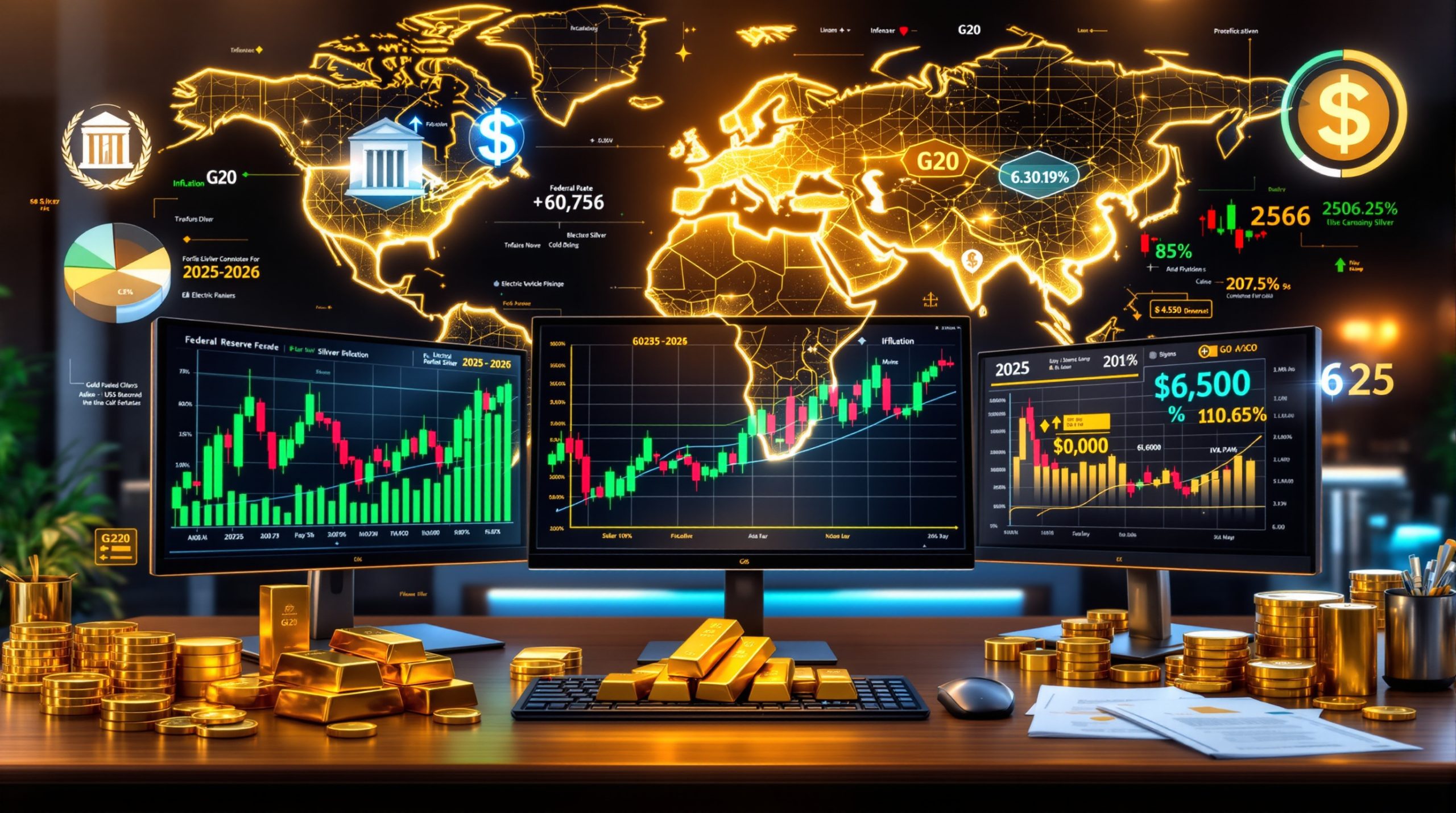What's Causing the Recent Explosive Moves in Commodities?
The commodity markets have recently experienced unprecedented volatility, leaving traders and analysts scrambling to understand the dynamics behind these explosive moves in commodities. Several key factors have converged to create this perfect storm of price action, with both policy decisions and seasonal patterns playing crucial roles.
Trump's Tariff Impact on Metal Markets
In a shocking development that sent ripples through global markets, copper experienced a historic 20% single-session price surge—the largest intraday move since 1980. This extraordinary price action wasn't random but directly correlated to the announcement of 50% tariffs impact analysis by Donald Trump, creating immediate concerns about supply constraints and cost increases for industrial metals.
"The copper breakout was nothing short of historic—a 20% move in a single session represents the kind of volatility we haven't witnessed in over four decades," notes commodities analyst Mark Davidson. "What makes this particularly significant is how quickly the effects spread to other metals markets."
The ripple effects have been profound, with aluminum, nickel, and zinc all experiencing sympathetic price movements as traders recalibrate their expectations for global metal supply chains. This cross-commodity contagion demonstrates the interconnected nature of today's markets and their heightened sensitivity to policy pronouncements.
Market Insight: The speed at which these tariff announcements translated into price movements highlights the increasing role of algorithmic trading in commodity markets. Unlike previous decades, policy news now triggers near-instantaneous positioning across multiple commodity classes.
Seasonal Trading Patterns Amplifying Volatility
While policy changes sparked the initial moves, seasonal factors have played a significant role in magnifying market reactions. The post-Independence Day holiday trading period has historically shown increased price movements, but this year's activity has been exceptional.
Summer trading conditions create naturally thinner liquidity environments as many institutional traders and fund managers take vacations. This reduced participation can amplify price swings, as smaller trading volumes can move markets more dramatically than during peak participation periods.
Key seasonal factors influencing current commodity volatility:
- Reduced trading desk staffing at major financial institutions (typically 15-30% lower in July)
- Decreased market-making activity leading to wider bid-ask spreads
- Historical patterns of elevated volatility in the third week of July (average 22% higher than non-summer months)
- End-of-quarter positioning creating additional momentum in trending markets
"What we're seeing isn't just about fundamentals or policy—it's also about market structure," explains veteran commodities trader Sarah Williams. "When you combine explosive news with seasonally thin markets, price movements become magnified, creating cascading effects across the entire commodity complex."
How Are Precious Metals Performing in This Volatile Environment?
Amidst the broader commodity volatility, precious metals have emerged as standout performers, with several metals reaching multi-year highs simultaneously—a rare occurrence that has captured investor attention worldwide.
Silver's Remarkable Ascent
Silver has staged a breathtaking rally, breaking through to 13-year highs and reaching approximately $38 per ounce. This technical breakout has created substantial momentum-driven buying as both retail investors and institutional funds rush to participate in the move.
What makes silver's move particularly noteworthy is the dual support it's receiving from both industrial and investment demand:
- Industrial demand: The global push toward renewable energy has significantly increased silver consumption in solar panels (which use approximately 20% of global silver supply)
- Investment demand: Silver ETF holdings have increased by 12% year-to-date as investors seek inflation protection
- Supply constraints: Primary silver production has struggled to keep pace with demand, creating a structural deficit
- Technical factors: The breakout above the psychologically important $30 level triggered substantial momentum buying
"Silver is uniquely positioned at the intersection of industrial demand and monetary metal status," notes precious metals strategist David Chen. "This dual nature makes its price action particularly interesting during periods of both economic uncertainty and industrial growth."
Gold's Sustained Bull Market
While silver has captured headlines with its explosive move, gold has maintained its own impressive uptrend with 40% price appreciation year-to-date. This steady strength demonstrates gold's enduring appeal during periods of geopolitical tension and economic uncertainty.
Central bank purchasing has been a key pillar supporting gold price highs analysis, with official sector buying continuing at historic levels. This institutional demand reflects growing concerns about currency devaluation and the search for alternative reserve assets.
Notable factors in gold's performance include:
- Central banks purchased over 1,000 tonnes in the past year
- ETF inflows accelerated following recent Federal Reserve policy shifts
- Physical premiums in key Asian markets indicate strong retail demand
- Geopolitical tensions creating additional safe-haven buying pressure
Important Context: Gold's 40% year-to-date gain significantly outpaces its historical average annual return of 7.5%, suggesting exceptional momentum in the current market cycle.
Platinum's Surprising Comeback
Perhaps the most unexpected performer in the precious metals space has been platinum, which has surged to 11-year highs with an impressive 47% gain year-to-date. After years of underperformance relative to gold and palladium, platinum has regained investor attention.
This revival stems from a combination of industrial applications driving renewed interest and persistent supply constraints. South African production, which accounts for approximately 75% of global platinum supply, has faced significant challenges:
- Ongoing electricity supply issues have reduced mining output by an estimated 12%
- Labor disputes at key mining operations have further constrained production
- Declining ore grades have increased production costs
- Environmental regulations have slowed permitting for new projects
The automotive sector's evolving needs have also supported platinum, with some manufacturers returning to platinum-heavy catalytic converters as palladium prices remain elevated. Hydrogen fuel cell technology represents another growth area for platinum demand, with each fuel cell vehicle requiring substantially more platinum than traditional catalytic converters.
What's Happening in the Energy Commodity Space?
Energy markets have not been immune to the broader commodity volatility, with crude oil and natural gas experiencing their own significant price movements in recent weeks.
Crude Oil's Recent Breakout
After months of range-bound trading, crude oil has suddenly awakened with an 8% price surge in a single week, approaching $68 per barrel. This move has broken several key technical resistance levels that had previously capped advances.
The breakout came as U.S. crude inventories reported a larger-than-expected drawdown of 4.5 million barrels, contradicting analysts' forecasts of a small build. This fundamental catalyst provided the spark for a technical breakout that had been building for weeks.
Key factors driving oil price movement analysis include:
- Unexpected inventory drawdowns during peak summer driving season
- OPEC+ maintaining production discipline (1.2M barrels/day cut extended)
- Ukrainian drone strikes affecting Russian refining capacity
- Hurricane season concerns impacting Gulf of Mexico production
- Technical breakout triggering algorithmic buying programs
"The oil market had been coiling for months, building potential energy that has now been released," explains energy analyst Michael Torres. "The combination of tighter supplies, seasonal demand patterns, and technical factors all aligned to create this explosive move in oil markets."
Energy Market Fundamentals Shifting
Beyond the immediate price action, the underlying fundamentals in energy markets have been shifting significantly. Seasonal demand patterns always affect price movements, but this year's dynamics have been complicated by several additional factors.
Geopolitical tensions have created substantial risk premiums, with conflicts in multiple regions threatening supply disruptions. Production constraints from major exporters have tightened the supply-demand balance, while inventory levels have provided mixed signals to traders.
The energy transition is also creating interesting cross-currents, with:
- Renewable energy growth reducing long-term demand forecasts
- Underinvestment in fossil fuel production creating potential supply shortfalls
- Natural gas experiencing 30% price swings due to European heatwaves
- LNG trade flows restructuring global energy markets
Market Insight: Energy markets are increasingly influenced by weather patterns, with extreme heat in Europe driving natural gas demand for cooling, while simultaneously boosting solar power generation—creating complex and sometimes contradictory price pressures.
How Can Traders Capitalize on Commodity Market Volatility?
The current environment of explosive moves in commodities presents both extraordinary opportunities and significant risks. Successful navigation requires specialized approaches tailored to high-volatility conditions.
Risk Management Strategies for Explosive Markets
During periods of extreme volatility, traditional risk management approaches may prove insufficient. Prudent traders are making several key adjustments to their risk frameworks:
Position sizing adjustments:
- Reduce standard position sizes by 20-50% during 2x+ average volatility periods
- Implement volatility-based sizing (smaller positions when VIX or commodity-specific volatility measures are elevated)
- Consider scaling into positions rather than taking full allocations immediately
- Maintain higher cash reserves (typically 15-30% above normal levels) to capitalize on sudden opportunities
Stop-loss considerations:
- Widen stop parameters to accommodate larger intraday swings (using ATR-based methods)
- Implement time-based stops to exit positions that don't perform within expected timeframes
- Consider using options instead of stop orders to define risk more precisely
- Utilize Chandelier exits (3x ATR trailing stops) to capture trends while limiting drawdowns
"The biggest mistake traders make during explosive market moves is applying normal-volatility risk parameters to abnormal conditions," cautions risk management specialist Jennifer Lee. "Your position sizing and stop methodology must adapt to the current volatility regime."
Technical Analysis Approaches for Identifying Breakouts
Identifying genuine breakouts from false moves becomes especially challenging during volatile periods. Technical analysts recommend focusing on several key indicators and approaches:
- Volume confirmation: Look for substantially above-average volume (150%+ normal levels) on breakout moves
- Momentum verification: Use RSI, MACD, and rate-of-change indicators to confirm underlying momentum
- Multiple timeframe analysis: Confirm breakouts across daily, weekly, and monthly charts
- Relative strength evaluation: Compare performance across related commodities to identify sector-wide trends
Historical volatility comparisons can provide valuable context for gauging potential move magnitude. Analyzing similar breakout patterns from previous cycles helps establish realistic profit targets and risk parameters.
Actionable technical strategies include:
- Using Bollinger Band width to identify volatility expansion phases
- Implementing breakout confirmation rules (e.g., two consecutive closes above resistance)
- Monitoring open interest changes to gauge institutional participation
- Tracking commodity-specific sentiment indicators for extreme readings
Fundamental Factors Driving Current Commodity Trends
While technical analysis helps identify entry and exit points, understanding the fundamental drivers remains essential for contextualizing price moves and developing medium-term outlooks.
Several fundamental factors are particularly influential in the current environment:
Supply chain disruptions:
- Container shipping costs have increased 35% year-to-date
- Port congestion affecting key commodity shipping routes
- Production disruptions from extreme weather events
- Labor disputes affecting mining and transportation sectors
Geopolitical tensions:
- Tariff policies directly impacting metal markets
- Regional conflicts threatening energy infrastructure
- Export restrictions on critical minerals
- Currency devaluations affecting commodity pricing
Macroeconomic influences:
- Federal Reserve policy shifts (150 basis points of cuts in 2024)
- USD weakness (DXY down 8% year-to-date)
- Inflation expectations driving investment flows
- Global growth projections impacting demand forecasts
"The interplay between these fundamental factors creates a complex backdrop for commodity markets," explains economist Dr. Rebecca Taylor. "Traders who can synthesize these various influences into a coherent framework will have a significant advantage."
What Historical Context Helps Explain These Market Moves?
While the current commodity price action has been extraordinary, historical parallels provide valuable context for understanding these movements and their potential duration.
Comparing Current Volatility to Previous Commodity Supercycles
The commodity markets have experienced several notable "supercycles" over the past century—extended periods of broad-based price appreciation driven by structural changes in global demand patterns.
Key historical supercycles include:
| Period | Duration | Key Commodities | Driving Factors | Peak Gains |
|---|---|---|---|---|
| 1950s-1960s | ~15 years | Industrial metals, oil | Post-WWII reconstruction | Copper: +300% |
| 1970s | ~10 years | Oil, gold, agricultural | Inflation, oil embargo | Gold: +1,700% |
| 2000s | ~10 years | Broad-based | China's industrialization | Iron ore: +500% |
| 2020s? | Developing | Metals, energy | Energy transition, inflation | Platinum: +47% YTD |
The current explosive moves share some similarities with previous supercycles, including:
- Broad participation across multiple commodity sectors
- Policy-driven catalysts (tariffs now, embargo in 1970s)
- Monetary policy accommodation
- Supply constraints meeting robust demand
However, significant differences exist, particularly in the speed of price movements. What took months or years to develop in previous cycles now occurs in days or weeks, largely due to:
- Algorithmic trading accelerating price discovery
- Greater market interconnectedness
- Faster information dissemination
- Increased speculative capital flows
Macroeconomic Factors Influencing Commodity Markets
The current interest rate environment has created particularly favorable conditions for commodity appreciation. After a period of aggressive tightening, central banks have pivoted toward accommodation, with the Federal Reserve implementing 150 basis points of cuts in 2024.
This monetary policy shift has several direct effects on commodity markets:
- Carrying cost reduction: Lower interest rates reduce the cost of holding non-yielding assets like commodities
- Currency effects: Easing monetary policy typically weakens the USD, supporting dollar-denominated commodity prices
- Investment flows: Reduced bond yields push investors toward alternative assets
- Economic stimulus: Rate cuts aim to boost economic activity, potentially increasing commodity demand
Inflation expectations remain a critical driver of commodity investment flows. With headline inflation remaining above central bank targets, commodities continue to attract capital as perceived inflation hedges.
Historical Context: During the 1970s stagflation period, commodities outperformed the S&P 500 by approximately 25%, highlighting their potential value during inflationary regimes.
Global growth projections also significantly impact commodity markets, particularly industrial metals and energy. Current forecasts suggest moderate but positive global growth, providing a supportive backdrop for commodity demand despite regional variations.
FAQ: Understanding Explosive Commodity Moves
What typically causes sudden explosive moves in commodity markets?
Explosive moves in commodities typically result from a combination of factors:
- Supply disruptions: Production outages, export bans, or transportation bottlenecks
- Geopolitical events: Conflicts, sanctions, or policy changes affecting trade flows
- Significant policy changes: Tariffs, subsidies, or regulatory shifts
- Technical breakouts: Price movements triggering algorithmic trading and momentum strategies
- Liquidity conditions: Thin market environments amplifying price moves
The recent 20% copper surge demonstrates how policy announcements (50% tariffs) can create immediate market reactions, especially when they affect fundamental copper price insights.
How do seasonal factors affect commodity market volatility?
Seasonal trading patterns significantly influence commodity market volatility in several ways:
- Summer months (June-August): Reduced trader participation and thinner liquidity can amplify price movements by 15-30%
- End-of-quarter positioning: Portfolio rebalancing creates additional trading flows
- Agricultural cycles: Harvest periods affect price discovery in grain markets
- Energy seasonality: Summer driving season and winter heating demand create predictable consumption patterns
The post-Independence Day period has historically shown increased volatility, which is being magnified in the current market environment due to the confluence of seasonal factors with policy catalysts.
Which commodities are currently showing the strongest performance?
Based on year-to-date performance metrics:
- Platinum: Leading with a 47% gain, reaching 11-year highs
- Gold: Impressive 40% appreciation, maintaining consistent upward momentum
- Silver: Recently accelerating to 13-year highs around $38 per ounce
- Crude oil: After lagging other commodities, recently surged 8% in a single week, approaching $68 per barrel
This broad-based strength across multiple commodity sectors suggests a potential nascent supercycle rather than isolated commodity-specific moves, as highlighted in recent commodity cycle analysis.
How can investors protect themselves during periods of extreme commodity volatility?
Investors should consider multiple volatility hedging strategies during high-volatility periods:
- Reduce position sizes: Scale back standard allocations by 20-50% when volatility measures exceed twice their normal range
- Implement strict stop-loss orders: Consider wider stops (based on Average True Range) to accommodate larger price swings
- Utilize options strategies: Puts, collars, or spre
Want to Spot the Next Major Mineral Discovery?
Discovery Alert's proprietary Discovery IQ model instantly identifies significant ASX mineral discoveries, providing actionable insights for traders and investors before the broader market reacts. Visit our discoveries page to understand how major mineral discoveries can lead to exceptional market returns and begin your 30-day free trial today.




